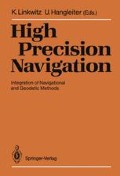Abstract
Stereo vision is an attractive approach to depth sensing in many robotics applications. To date, most research in stereo has concentrated on the analysis of a single stereo image pair. However, many applications will involve moving robot systems that can acquire sequences of stereo pairs from successive robot positions. Such systems can achieve greatly improved stereo performance by appropriately controlling the motion of the cameras and by using depth information obtained from early images to guide the interpretation of later images. This requires a representation for the depth model at any point in time, methods for using the model to influence matching in subsequent images, and methods for controlling the motion of the cameras that take into account the degree of uncertainty in the depth model. In this paper, we propose a Bayesian approach to processing stereo image sequences that serves these requirements. The approach is based on representing, predicting, and updating depth and depth variance at every pixel in the image. We describe a vision system under development for a robot vehicle that incorporates this approach and summarize implementation results for parts of the system.1
Access this chapter
Tax calculation will be finalised at checkout
Purchases are for personal use only
Preview
Unable to display preview. Download preview PDF.
References
N. Ayache and O.D. Faugeras. Building, registrating, and fusing visual maps. In Proc. 1st Int’l Conf. on Computer Vision, pages 73–82, IEEE, June 1987.
H. H. Baker and T. O. Binford. Depth from edge and intensity based stereo. In Proc. 7th Int’l Joint Conf. on Artifical Intelligence, pages 631–636, August 1981.
S. T. Barnard. Stochastic stereo matching over scale. In Proc. DARPA Image Understanding Workshop, pages 769–778, Morgan Kaufman Publishers, April 1988.
R. C. Bolles, H. H. Baker, and D. H. Marimont. Epipolar-plane image analysis: an approach to determining structure from motion. International Journal of Computer Vision, 1: 7–55, 1987.
J. L. Crowley. A Representation for Visual Information. PhD thesis, Carnegie-Mellon University, November 1981.
W. Forstner and A. Pertl. Photogrammetric standard methods and digital image matching techniques for high precision surface measurements. In E. S. Gelsema and L. N. Kanal, editors, Pattern Recognition in Practice II, pages 57–72, Elsevier Science Publishers, 1986.
D. Geiger and A. Yuille. Stereopsis and eye-movement In Proc. 1st Int’l Conf. on Computer Vision, pages 306–314, IEEE, June 1987.
S. Geman and D. Geman. Stochastic relaxation, gibbs distribution, and the bayesian restoration of images. IEEE Trans. Pattern Analysis and Machine Intelligence, PAMI-6(6): 721–741, November 1984.
D. B. Gennery. Modelling the Environment of an Exploring Vehicle by Means of Stereo Vision. PhD thesis, Stanford University, June 1980.
D. B. Gennery. Tracking known three-dimensional objects. In Proc. Of AAAI, pages 13–17, Morgan Kaufman Publishers, 1982.
W. E. L. Grimson. Computational experiments with a feature based stereo algorithm. IEEE Trans. Pattern Analysis and Machine Intelligence, PAMI-7(1): 17–34, January 1985.
M. Kass. A computational framework for the visual correspondence problem. In Proc. 8th Int’l Joint Conf. on Artifical Intelligence, pages 1043–1045, Karlsruhe, W. Germany, August 1983.
D. Marr and T. Poggio. Cooperative computation of stereo disparity. Science, 194: 283–287, 1976.
J. Marroquin, S. Mitter, and T. Poggio. Probabilistic solution of ill-posed problems in computational vision. Journal of the American Statistical Association, 82 (397): 76–89, March 1987.
L. H. Matthies. A Bayesian Foundation for Motion Stereo. PhD thesis, Carnegie-Mellon University, in preparation.
L. H. Matthies and T. Kanade. The cycle of uncertainty and constraint in robot perception. In Robotics Research 4, MIT Press, in press.
L. H. Matthies and S. A. Shafer. Error modeling in stereo navigation. IEEE J. Robotics and Automation, RA-3(3): 239–248, June 1987.
L. H. Matthies, R. Szeliski, and T. Kanade. Kaiman Filter-based Algorithms for Estimating Depth from Image Sequences. Technical Report CMU-CS-87-185, Computer Science Department, Carnegie Mellon University, December 1987.
P. S. Maybeck. Stochastic Models, Estimation, and Control. Volume 1, Academic Press, New York, NY, 1979.
E.M. Mikhail. Observations and Least Squares. University Press of America, Lanham, MD, 1976.
V. J. Milenkovic and T. Kanade. Trinocular vision using photometric and edge orientation constraints. In Proc. DARPA Image Understanding Workshop, Dec. 1985.
H. P. Moravec. Obstacle Avoidance and Navigation in the Real World by a Seeing Robot Rover. PhD thesis, Stanford University, September 1980.
Y. Ohta and T. Kanade. Stereo by intra- and inter-scanline search using dynamic programming. IEEE Trans. Pattern Analysis and Machine Intelligence, PAMI-7(2): 139–154, March 1985.
R. Szeliski. Regularization uses fractal priors. In Proc. AAAI-87, pages 749–754, Morgan Kaufman Publishers, July 1987.
C. E. Thorpe. Vision and Navigation for a Robot Rover. PhD thesis, Carnegie-Mellon University, December 1984.
H.-J. Wunsche. Detection and control of mobile robot motion by real-time computer vision. In Proc. SPIE Conf. on Mobile Robots, October 1986.
G. Xu, S. Tsuji, and A. Minora. Coarse-to-fine control strategy for matching motion stereo pairs. In Proceedings of IJCAI, pages 892–894, 1985.
Author information
Authors and Affiliations
Editor information
Editors and Affiliations
Rights and permissions
Copyright information
© 1989 Springer-Verlag Berlin Heidelberg
About this paper
Cite this paper
Matthies, L. (1989). Depth from Stereo Image Sequences. In: Linkwitz, K., Hangleiter, U. (eds) High Precision Navigation. Springer, Berlin, Heidelberg. https://doi.org/10.1007/978-3-642-74585-0_25
Download citation
DOI: https://doi.org/10.1007/978-3-642-74585-0_25
Publisher Name: Springer, Berlin, Heidelberg
Print ISBN: 978-3-642-74587-4
Online ISBN: 978-3-642-74585-0
eBook Packages: Springer Book Archive

